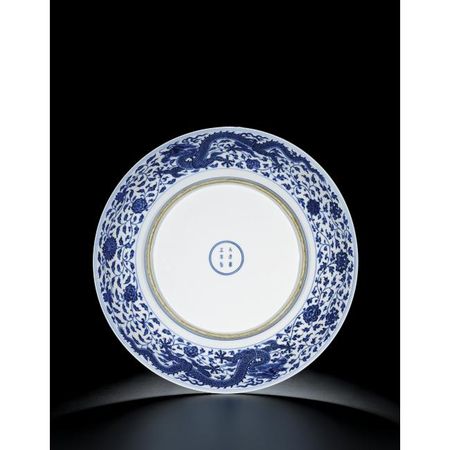A superbly painted large blue and white 'dragon' dish, mark and period of Yongzheng
A superbly painted large blue and white 'dragon' dish, mark and period of Yongzheng
the large well-potted body with rounded sides resting on a short slightly tapering foot, powerfully painted in rich tones of deep cobalt-blue with a medallion enclosing a large full-faced leaping winged dragon, its scaly five-clawed body encircling a 'flaming pearl', surrounded by a lotus scroll on meandering leafy stems, the sides with two further ferocious dragons pacing amid further scrollwork, all below a band of crested rolling waves at the rim, the reverse similarly decorated with the two dragons enclosed within double-line bands, the base inscribed with the six-character mark within double-circles. 50.3 cm., 19 7/8 in. Estimate 3,000,000—5,000,000 HKD
PROVENANCE: Acquired in Europe in the 1960s.
NOTE: Dishes of this magnificent size and formidable decoration were made to impress. They were used at Imperial banquets and on special celebratory occasions, such as the 'Thousand Elderly Banquet' in honour of senior citizens, when thousands of guests were invited to dine with the emperor and large quantities of meals were served. The Manchu custom of feasting closely followed the Mongolian and Tibetan tradition of shared communal dining. Perfectly potted, glazed and decorated pieces of this impressive large dimension were made for the Court in the Imperial kilns at Jingdezhen, Jiangxi province, where the most skilled and technically advanced artists were employed.
The decoration found on this dish is a Yongzheng period interpretation of a much earlier, Ming dynasty, pattern. The Yongzheng emperor was known to have sent antiques from the palace to Jingdezhen in order to set quality standards or for use as models and inspiration for designs. The dragon design is after a Xuande dish painted with a side-facing five-clawed dragon amongst lotus scroll in the centre and the side decorated with two dragons striding among peony flowers. An example of the Xuande dish can be found in the National Palace Museum, Taipei, illustrated in A Panorama of Ceramics in the Collection of the National Palace Museum. Hsuan-te Ware I, Taipei, 2000, pl. 2 (fig. 1); and another unmarked Xuande period dish is published in A.D. Brankston, Early Ming Wares of Chingtechen, Beijing, 1938, pl. 21 (a).
The creative ingenuity of the Yongzheng potter in his use of space is evident from the successful transfer of a pattern that was originally made for much smaller vessels. The different design elements on this dish are perfectly positioned and spaced with no overcrowding or awkward gap left that could hinder the overall harmony of the decoration. While maintaining the essence of the original design, the artist created a motif that is familiar yet spontaneous. The side-facing dragon has been replaced with a winged-dragon, yinglong, and the original lotus scroll decoration now includes a variety of flowers. The band of wind-tossed crested waves around the rim is an innovative addition to the original composition. It brings 'water' into the overall composition which is quintessential to the yinglong. The yinglong in Chinese mythology is associated with water and is said to have helped stop the Yellow River from flooding by digging channels with its tail. It is also the carrier of rain in times of draught. However, the wave-band can also be found on Xuande dishes without dragons but with the same flower scroll design as seen on the present piece; for example see a dish painted with a fine scrolling vine with flowers and with a similar border of crested waves, illustrated in John Alexander Pope, Chinese Porcelains from the Ardebil Shrine, Washington, 1956, pl. 34. fig. 29.88 (fig. 2).
Ming dynasty influence is also apparent in the stippled dots on the flowers and leaves of this dish that imitate those seen on early Ming blue-and-white vessels with the 'heaped-and-pile' effect caused by the surplus cobalt.
Another variation of the design found on this dish is that painted with a wingless front-facing five-clawed dragon amongst clouds clutching a shou medallion, with two pairs of smaller dragons in the well and with a waveband around the rim. See a Yongzheng mark and period dish of similar large dimensions, from the collection of the T.Y. Chao Family Foundation included in the exhibition Ming and Ch'ing Porcelain from the Collection of the T.Y. Chao Family Foundation, Hong Kong Museum of Art, Hong Kong, 1978, cat. no. 81, and sold in these rooms, 18th November 1986, lot 80 (fig. 3); and another in the Royal Ontario Museum, published in J.E. Vollmer (ed., ) Silk Roads – China Ships, Toronto, 1983, p. 229.
Yongzheng dishes of this type continued to be favoured by the Qianlong emperor who commissioned the making of very similar vessels. Compare a large dish with a Qianlong reign mark and of the period sold twice in our New York rooms, 23rd October 1976, lot 325, and again, 22nd March 2000, lot 133. Another Qianlong example was sold in these rooms, 26th November 1980, lot 311. Although Qianlong dishes closely follow the Yongzheng prototype, and are equally special and impressive, the flower scroll decoration is denser with the number of flower heads doubled while the leaves are also more uniform and crowded. The spontaneity and naturalness found in the Yongzheng design is replaced by a stylized and more ornate decoration. The presentation of the dragon also changed, with the Qianlong dragon being more slender and stylized compared to its Yongzheng counterpart.
Sotheby's. Eight Treasures from a European Collection. 08 Apr 09. Hong Kong. www.sothebys.com photo courtesy Sotheby's

/https%3A%2F%2Fprofilepics.canalblog.com%2Fprofilepics%2F1%2F0%2F100183.jpg)






/http%3A%2F%2Fstorage.canalblog.com%2F93%2F29%2F577050%2F66520041_o.jpg)
/http%3A%2F%2Fstorage.canalblog.com%2F38%2F84%2F119589%2F66518392_p.jpg)
/http%3A%2F%2Fstorage.canalblog.com%2F89%2F15%2F119589%2F66422513_p.jpg)
/http%3A%2F%2Fstorage.canalblog.com%2F64%2F75%2F577050%2F65928955_o.jpg)